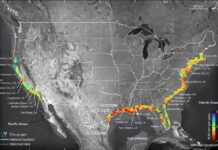By Jonah Ruddock
Kavachi, located in the Solomon Islands, is one of the southwest Pacific’s most active underwater volcanoes. It erupted a dozen times in the twentieth century and three times in the twenty first. In 2015, ocean engineer Brennan Phillips lowered an eighty-pound camera down into its roiling waters, hoping to take a closer look at it after a recent eruption. It rested 147 feet deep in the volcano’s caldera (a pit formed in the aftermath of a magma chamber’s collapse). When the camera resurfaced, Phillips and his team found unexpected footage of scalloped hammerhead sharks and silky sharks emerging from the murky orange surroundings to investigate the lens. A sixgill stingray was also caught on tape, and a sleeper shark- which had never before been seen around the Solomon Islands- was found twelve miles from the area.
Like so many things in marine biology, most of the details are unknown. How did they withstand the hot, acidic water of the caldera? Why did they choose such a dangerous place to live? In a National Geographic video that includes footage of the sharks, which can be found here, Phillips wonders: “When it’s erupting, there’s no way anything could live in there. And so to see large animals like this, that are living – and potentially they could die at any moment – it brings up lots of questions. Do they leave? Do they have some sort of sign that it’s about to erupt? Do they blow up sky-high into little bits?”
Some scientists have since suggested that a collection of pores in sharks’ noses, called the ampullae of Lorenzini, might be the answer. These pores allow them to sense changes in Earth’s magnetic field, and could alert them to coming eruptions. Michael Heithaus, who has spent the last few years studying these mysterious sharks, told 9News, “It looked like the sharks in the volcano were used to dealing with eruptions. You would think it’s dangerous, but studies have shown us they can detect approaching hurricanes and cyclones, so they may be able to detect when something bad is about to happen and move out of the way.”
Kavachi is not entirely unique. Off the coast of Reunion in the Indian Ocean and near Guadalupe Island in the Pacific Ocean, sharks can be found adapting to the hostile environments near underwater volcanoes, which provide nutrients to the water and attract fish for the sharks to prey on. The cloudy, ash-filled waters make for good hunting grounds, and people rarely go fishing around volcanoes. Overfishing is the gravest threat sharks face, and it’s not implausible that they have infiltrated the extreme conditions around volcanoes simply to escape from humans. Furthermore, sharks have been flocking to Israeli beaches. Seeing sharks gather in large groups is rare, especially in the Mediterranean, where their numbers are dwindling, but that is exactly what people are seeing near Ashdod and Hadera. The reason for this may be the same reason they populate volcanoes: they are safe from fishermen there. It is illegal to fish for sharks in Israel, as they are registered as protected natural assets.
Sharks are 450 million years old, which means they existed on this planet before trees did and shared ancient seas with mosasaurs. They have endured five major extinctions. Their ability to live in marine volcanoes, while incredible, only adds to their already legendary status.










